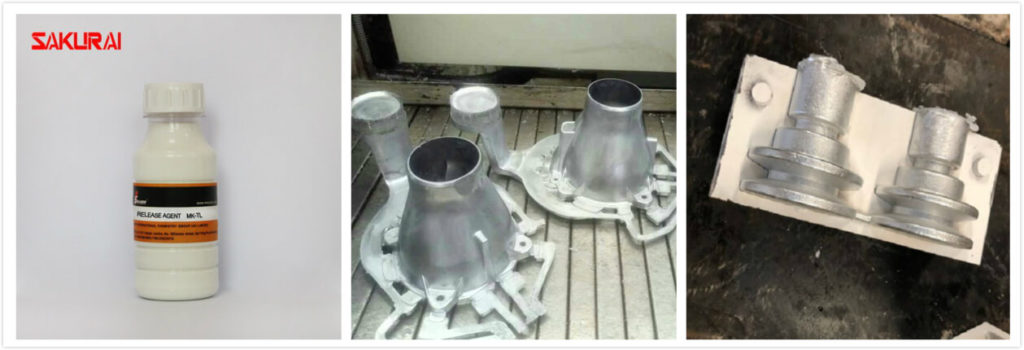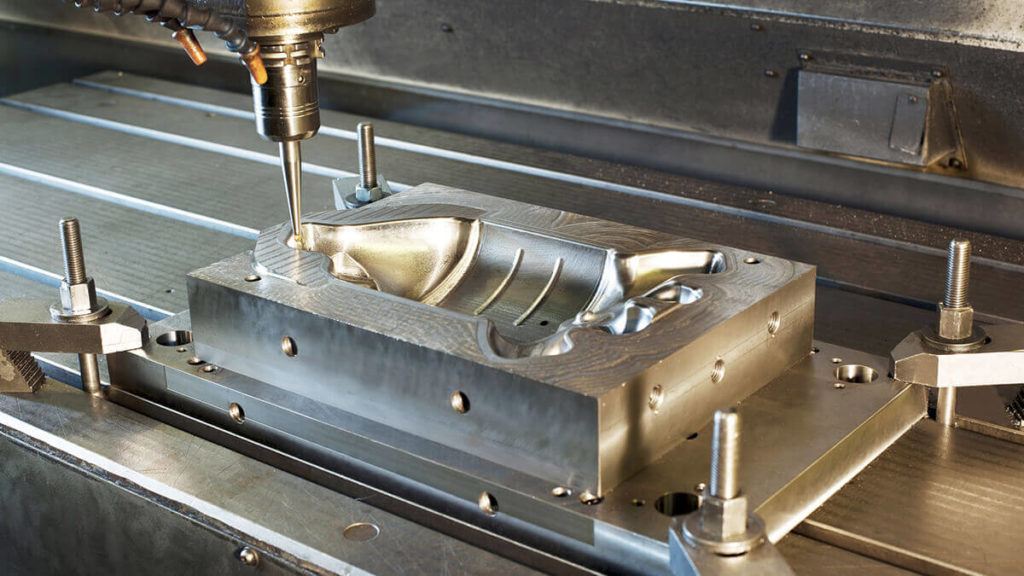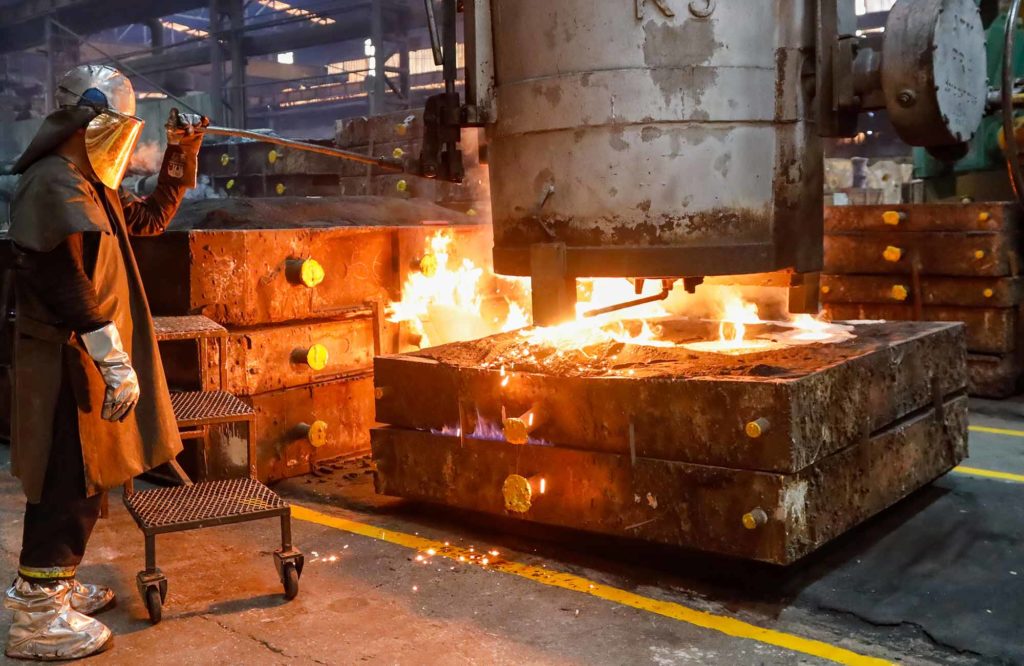In the die casting production, in order to prolong the service life of the die cavity and plunger sleeve, and make die casting process smoothly, ensure the surface of the die casting pieces brightly, the forming outline is complete, it is necessary to use some auxiliary materials, such as release agent, plunger lubricant and so on.

As a professional die casting mold release agent manufacturer, our company has 40 years of experience in manufacturing mold release agents. We write this article to help our customers with the selection and purchase of die casting mold release agents.
-
What is Die Casting Process
Die casting is a casting method that pours fusion gold liquid into the press chamber, fills the cavity of steel mold at high speed, and solidifies the alloy liquid under pressure to form castings.
Die casting is divided into high-pressure and low-voltage casting.
The main characteristics of high-pressure die casting that distinguish it from other casting methods are high voltage and high speed. With high productivity, high casting size accuracy, and good surface quality, most die-cast alloys are iron-free, such as zinc, copper, aluminum, magnesium, lead, tin, and lead-tin alloys and their alloys.
For different die-casting components, the quality and requirements of the release agent are different.
2. Why Need Mold Release Agent For Die Casting Process(the importance of mold release agent in die casting)
The release agent is a functional substance between the mold and the finished product. It is a kind of processing aid that plays a role in separation. The use of release agents in the process of release can make the product smooth and bright, make the release operation easier, prevent damage to the product when demolding, reduce the rejection rate.
In the die casting production, in order to prolong the service life of the die cavity and plunger sleeve, and make die casting process smoothly, ensure the surface of the die casting pieces brightly, the forming outline is complete, it is necessary to use some auxiliary materials, such as release agent, plunger lubricant and so on.
3. Types of Mold Release Agent For Die Casting
According to the classification of metals, SAKURAI die casting release agent is mainly divided into aluminum alloy die casting release agent, magnesium alloy die casting release agent and zinc alloy die casting release agent. And the different thickness of each metal part also has different demands of release agent, thin parts for the release agent requirements are higher.
Die casting release agent can also be divided into silicon and non-silicon type, if high requirements for post-processing, such as paint, plating and anodizing, this situation needs to use silicon free die casting release agent helpfully.
4.Applications Of Sakurai Mold Release Agent
Sakurai release agent can be applied to the molding of various types of metal die casting accessories such as engine cylinder block, cylinder head, oil sump, gearbox housing, wheel hub, and so on. The shapes of parts can be roughly divided into six categories:
- Disk class – no. Disk seat, etc.;
- Round cover class – table cover, machine cover, chassis, etc.;
- Ring class – connector, bearing retainer, steering wheel, etc.
- Cylinder class – flange coat, catheter, shell shape cover shell cover, cover, instrument cover, probe control instrument cover, camera shell and carburetor, etc.
- Porous cylinder body, shell class – cylinder body, cylinder head and oil pump body and other multi-cavity structure is more complex shell (this kind of parts have high requirements for mechanical properties and air tightness, the material is generally aluminum alloy).For example, car and motorcycle cylinder body, cylinder head;
- Special shape class — impeller, horn, font composed of rib decorative die casting, etc.
5. Benefits of Die Casting Mold Release Agent
- Superior demolding performance — sprayed on the surface of the mold, the effective ingredients immediately form a dense film. The film is resistant to high pressure and scour in the injection process, and can effectively prevent the welding of die casting products and molds. Play to release anti-stick to prevent product variation. At the same time, the excellent lubrication performance accelerates the fluidity of liquid aluminum, so that liquid aluminum can be quickly formed in the cavity. Avoid product defects.
- High surface finish – Sakurai release agent using rare special materials.Can effectively solve the casting surface blackening, excessive water lines, help product processing, such as polishing, electroplating and spraying surface treatment.
- Fully protect the mold — a protective film is formed on the surface of the mold.Effectively reduce the heat and mechanical impact of liquid aluminum on the mold.The correct choice of high quality release agent can effectively protect the mold, prolong the use time of the mold, and reduce the number of mold repair.
- No carbon deposit performance — after use, no carbon deposit, no dirt, no oxide scale, effectively reduce the number of mold cleaning, the surface of the product is smooth and bright.
- Excellent high temperature resistance – even at 300℃ high temperature to inhibit the role of high temperature sintering, has good thermal stability and chemical stability.No oxidation, no combustion, no corrosion of mold and surface decomposition residue within the range of service temperature.
- Good cooling effect — the mold temperature can be effectively controlled in the process of die casting. Excessively high mold temperature will cause defects in the die casting.Such as: stick mold, blister, hot crack and burn.At the same time, long-term high temperature work of the die is easy to cause cracks and service life of the die.
- High safety performance – non-toxic, non-flammable, non-corrosive, no chemical reaction.In the use of the process does not contain harmful smoke.There is no residue on the surface of the mold and the product, and it is easy to clean and maintain.
6. How to use mold release agent for die casting process
Die-casting release agent mostly using water-based version, should be considered first in the use of release agent, spray or brush, the thickness of the coating is not too thick but even, after diluent volatile then close mold for die casting, thereby avoiding the cavity or the increased amount of gas chamber pressure and the possibility of casting blowholes, avoid due to the increase of the gas to form a high backpressure, make forming difficult.
In the process, the exhaust system should be wrongly at any time to avoid the loss of the exhaust system due to the blockage of the release agent. At the same time, it should avoid the accumulation of the release agent at the turning and convex angles, so as to avoid the unclear outline of the die casting.
7. When buy die casting mold release agent, what are the things to concern about?
In the selection of the die casting release agent, pay attention to the following requirements:
- Low volatilization point, at 100-150℃, water diluent can quickly volatilize off, does not increase the gas in the cavity;
- Good coating property, no accumulation, can form a film layer at high temperature, and easy to clean;
- No corrosion effect on molds and castings;
- Pollution to the environment can be as small as possible, that is, tasteless, no precipitation or decomposition of harmful gases;
- Stable performance, in the air is not volatile, storage period, no precipitation, no decomposition;
- Simple preparation process and easy to use.




